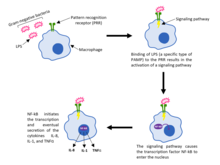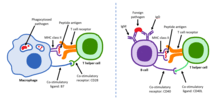Immune response
An immune response is a reaction which occurs within an organism for the purpose of defending against foreign invaders. These invaders include a wide variety of different microorganisms including viruses, bacteria, parasites, and fungi which could cause serious problems to the health of the host organism if not cleared from the body.[1] There are two distinct aspects of the immune response, the innate and the adaptive, which work together to protect against pathogens. The innate branch—the body's first reaction to an invader—is known to be a non-specific and quick response to any sort of pathogen. Components of the innate immune response include physical barriers like the skin and mucous membranes, immune cells such as neutrophils, macrophages, and monocytes, and soluble factors including cytokines and complement.[2] On the other hand, the adaptive branch is the body's immune response which is catered against specific antigens and thus, it takes longer to activate the components involved. The adaptive branch include cells such as dendritic cells, T cell, and B cells as well as antibodies—also known as immunoglobulins—which directly interact with antigen and are a very important component for a strong response against an invader.[1]
The first contact that an organism has with a particular antigen will result in the production of effector T and B cells which are activated cells that defend against the pathogen. The production of these effector cells as a result of the first-time exposure is called a primary immune response. Memory T and memory B cells are also produced in the case that the same pathogen enters the organism again. If the organism does happen to become re-exposed to the same pathogen, the secondary immune response will kick in and the immune system will be able to respond in both a fast and strong manner because of the memory cells from the first exposure.[3] Vaccines introduce a weakened, killed, or fragmented microorganism in order to evoke a primary immune response. This is so that in the case that an exposure to the real pathogen occurs, the body can rely on the secondary immune response to quickly defend against it.[4]
Innate

The innate immune response is an organism's first response to foreign invaders. This immune response is evolutionary conserved across many different species with all multi-cellular organisms having some sort of variation of an innate response.[5] The innate immune system consists of physical barriers such as skin and mucous membranes, various cell types like neutrophils, macrophages, and monocytes, and soluble factors including cytokines and complement.[2] In contrast to the adaptive immune response, the innate response is not specific to any one foreign invader and as a result, works quickly to rid the body of pathogens.
Pathogens are recognized and detected via pattern recognition receptors (PRR). These receptors are structures on the surface of macrophages which are capable of binding foreign invaders and thus initiating cell signalling within the immune cell. Specifically, the PRRs identify pathogen-associated molecular patterns (PAMPs) which are integral structural components of pathogens. Examples of PAMPs include the peptidoglycan cell wall or LPS, both of which are essential components of bacteria and are therefore evolutionarily conserved across many different bacterial species.[6]
When a foreign pathogen bypasses the physical barriers and enters an organism, the PRRs on macrophages will recognize and bind to specific PAMPs. This binding results in the activation of a signalling pathway which allows for the transcription factor NF-κB to enter the nucleus of the macrophage and initiate the transcription and eventual secretion of various cytokines such as Il-8, Il-1, and TNFα.[5] Release of these cytokines is necessary for the entry of neutrophils from the blood vessels to the infected tissue. Once neutrophils enter the tissue, like macrophages, they are able to phagocytize and kill any pathogens or microbes.
Complement, another component of the innate immune system, consists of three pathways that are activated in distinct ways. Each of the three pathways ensures that complement will still be functional if one pathway ceases to work or a foreign invader is able to evade one of these pathways.[5]
Adaptive

The adaptive immune response is the body's second line of defense. The cells of the adaptive immune system are extremely specific because during early developmental stages the B and T cells develop antigen receptors that are specific to only certain antigens. This is extremely important for B and T cell activation. B and T cells are extremely dangerous cells, and if they are able to attack without undergoing a rigorous process of activation, a faulty B or T cell can begin exterminating the host's own healthy cells.[7] Activation of naïve helper T cells occurs when antigen-presenting cells (APCs) present foreign antigen via MHC class II molecules on their cell surface. These APCs include dendritic cells, B cells, and macrophages which are specially equipped not only with MHC class II but also with co-stimulatory ligands which are recognized by co-stimulatory receptors on helper T cells. Without the co-stimulatory molecules, the adaptive immune response would be inefficient and T cells would become anergic. Several T cell subgroups can be activated by professional APCs, and each T cell is specially equipped to deal with each unique microbial pathogen. The type of T cell activated and the type of response generated depends, in part, on the context in which the APC first encountered the antigen.[8] Once helper T cells are activated, they are able to activate naïve B cells in the lymph node. However, B cell activation is a two-step process. Firstly, B cell receptors, which are just IgM and IgD antibodies specific to the particular B cell, must bind to the antigen which then results in internal processing so that it is presented on the MHC class II molecules of the B cell. Once this happens a T helper cell which is able to identify the antigen bound to the MHC interacts with its co-stimulatory molecule and activates the B cell. As a result, the B cell becomes a plasma cell which secretes antibodies that act as an opsonin against invaders.
Specificity in the adaptive branch is due to the fact that every B and T cell is different. Thus there is a diverse community of cells ready to recognize and attack a full range of invaders.[7] The trade-off, however, is that the adaptive immune response is much slower than the body's innate response because its cells are extremely specific and activation is required before it is able to actually act. In addition to specificity, the adaptive immune response is also known for immunological memory. After encountering an antigen, the immune system produces memory T and B cells which allow for a speedier, more robust immune response in the case that the organism ever encounters the same antigen again.[7]
References
- Sompayrac, Lauren. How the immune system works (Sixth ed.). Hoboken, NJ. ISBN 978-1-119-54219-3. OCLC 1083704429.
- Clinical immunology : principles and practice. Rich, Robert R. (Fifth ed.). [St. Louis, Mo.] 2018-01-13. ISBN 978-0-7020-7039-6. OCLC 1023865227.CS1 maint: others (link)
- "Immune system - Evolution of the immune system". Encyclopedia Britannica. Retrieved 2020-03-09.
- "vaccine | Definition, Types, History, & Facts". Encyclopedia Britannica. Retrieved 2020-03-09.
- Punt, Jenni (2018-03-12). Kuby immunology. Stranford, Sharon A.,, Jones, Patricia P.,, Owen, Judith A. (Eighth ed.). New York. ISBN 978-1-4641-8978-4. OCLC 1002672752.
- "The Innate Immune System: Early Induced Innate Immunity: PAMPs". faculty.ccbcmd.edu. Retrieved 2020-03-08.
- Bonilla FA, Oettgen HC (February 2010). "Adaptive immunity". The Journal of Allergy and Clinical Immunology. 125 (2 Suppl 2): S33-40. doi:10.1016/j.jaci.2009.09.017. PMID 20061006.
- Janeway CA, Travers P, Walport M, Shlomchik MJ (2001). Immunobiology (5th ed.). New York and London: Garland Science. ISBN 0-8153-4101-6.
External links
| Wikimedia Commons has media related to Immune response. |